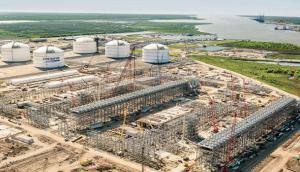A Two-fer in Texas Monthly
 I have two stories in the June issue of Texas Monthly. In my regular column, I take a look at the burgeoning business of liquefied natural gas exports and how Texas, which helped pioneer the process of hydraulic fracturing, is now leading the way on the next phase of the natural gas boom — exporting production to countries in Asia and Europe. Here’s a sample:
I have two stories in the June issue of Texas Monthly. In my regular column, I take a look at the burgeoning business of liquefied natural gas exports and how Texas, which helped pioneer the process of hydraulic fracturing, is now leading the way on the next phase of the natural gas boom — exporting production to countries in Asia and Europe. Here’s a sample:
Four years ago, things looked bleak for Houston’s Cheniere Energy. It had about $3 billion in debt, its stock price had plunged from more than $40 to less than $1 in a year’s time, and bankruptcy seemed imminent. Cheniere had made one of the biggest wrong-way bets in the history of natural gas, a commodity that is the poster child for wrong-way bets. With America’s natural gas supplies growing thin, Cheniere built a massive terminal in Sabine Pass, just across the border in Louisiana, to import liquefied natural gas (LNG). But by the time it completed the project, the hydraulic fracturing boom had changed everything. U.S. gas production was soaring. The idea of importing the stuff suddenly looked like a Texas twist on the British idiom of carrying coals to Newcastle.
Cheniere’s response: take advantage of the fracking boom by betting billions more on revamping its terminal and sending the gas the other way—which turned out to be a right-way bet. In May 2011 Cheniere became the first company in the country to get a permit from the Department of Energy to export LNG to countries in Asia. More precisely, Cheniere’s customers will bring natural gas to the Sabine Pass facility, which Cheniere will turn into LNG and pump onto customers’ ships that are bound for overseas markets.
Cheniere isn’t alone. Freeport LNG, also based in Houston, has been on the same roller coaster. It too got burned by investing a billion dollars in an import facility, on Quintana Island, just down the coast from Galveston.
I also wrote about the Securities and Exchange Commission’s insider trading case against Dallas billionaire Sam Wyly. It was a must-win case for the SEC, especially after it lost a similar one against another Dallas billionaire. As I explain in the story:
The SEC can’t afford to lose. For years, the commission had a practice of allowing defendants to pay a fine without admitting wrongdoing. It was, from the perspective of some prosecutors and defendants, a win-win solution: the government got to collect hefty fines without risking embarrassing and expensive losses in the courtroom, and defendants got to save face by merely paying a fine that most of them could handily afford. But in 2009 a federal judge in New York balked at such an arrangement in a settlement of claims that Bank of America had misled shareholders about $5.8 billion paid to Merrill Lynch employees. He referred to the SEC’s practice as “a contrivance designed to provide the SEC with the facade of enforcement.” Two years later, the same judge refused to sign off on a similar deal with Citigroup. After that, the SEC decided to stop making such deals. And the defendants started lawyering up and fighting back, with results that the New York judge may not have expected.





